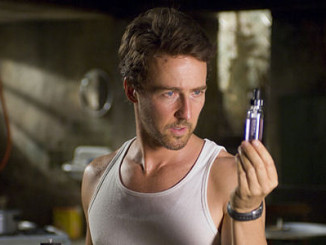In a multi-part series, Comic Book Film Editor William Gatevackes will be tracing the history of comic book movies from the earliest days of the film serials to today’s big blockbusters and beyond. Along with the history lesson, Bill will be covering some of the most prominent comic book films over the years and why they were so special. Today, the first X-Men film enters its home stretch, but not without a lot of belt tightening.
The prospects of an X-Men film might have continued to be grim if it wasn’t for a cartoon.
Love the logos for the team members. You can tell which teammate had a comic book because their logos are far superior.
 X-Men: The Animated Series debuted on the Fox Television network with a sneak preview on October 31, 1992 and would earn a permanent spot on the network’s “Fox Kids” Saturday morning line-up the following January. It quickly became one of the most successful cartoons in that block of programming, and executives at 20th Century Fox began to realize the fan base the property had. The live-action film rights, after a brief dalliance with Columbia Pictures about that studio picking them up, were still available. So, in 1994, a year after the X-Men cartoon began its Saturday morning run on Fox’s TV network, their film studio picked up the live-action rights to the characters and the mutants began their inevitable march to the big screen.
X-Men: The Animated Series debuted on the Fox Television network with a sneak preview on October 31, 1992 and would earn a permanent spot on the network’s “Fox Kids” Saturday morning line-up the following January. It quickly became one of the most successful cartoons in that block of programming, and executives at 20th Century Fox began to realize the fan base the property had. The live-action film rights, after a brief dalliance with Columbia Pictures about that studio picking them up, were still available. So, in 1994, a year after the X-Men cartoon began its Saturday morning run on Fox’s TV network, their film studio picked up the live-action rights to the characters and the mutants began their inevitable march to the big screen.
Even though 20th Century Fox was the most financially secure company to own the rights to the X-Men film, budget concerns were still an issue. If you were to look at the various treatments that were proposed during the six years it took for Fox to bring the X-Men to the big screen, you can see a trend with each script or treatment—they kept getting cheaper and cheaper.
Andrew Kevin Walker was first tapped to write a script for the film in 1994. As you would expect from the writer of Se7en, this treatment is rather dark. Mutants must register with the government or risk being hunted down and used in experiments to create a breed of super-soldiers. The X-Man Angel has his wings violently ripped off by Brotherhood of Evil Mutants member Sabretooth. And the X-Men not only have to face off against Magneto and his lackeys, but also the Federal government who attack the team with giant robots called Sentinels, familiar to anyone who has read the comics.
It’s easy to see why this treatment wasn’t chosen. While it would have made for an interesting film, it would have most likely set the record for the most expensive film ever made. In addition to the Sentinels, you had a cast that featured the original comic book X-Men (Cyclops, Beast, Jean Grey, Iceman and Angel) with, of course, Wolverine facing off against Magneto and his Brotherhood (Sabretooth, Toad, Blob and Juggernaut), scenes that took place in the X-Men’s Danger Room training area and a finale that featured Magneto and his group invading Manhattan, cutting it off from the rest of the U.S. (by the pricey CGI effects of destroying all bridges and flooding all tunnels leading into the island) to claim it as the mutant safe haven/homeland.
 Two years later, author Michael Chabon was asked to write a treatment for the film. His version included no super powered villains, but rather pit the X-Men against a shadowy, anti-mutant organization called The League of Gentlemen. Chabon focuses, of course, on Wolverine (who was being conditioned by the League to hunt down other mutants for them) and Jubilee (a popular character from the comics and the cartoon at the time whose parents played a role in the League’s actions). Chabon, makes the team an allegory for the closeted homosexual (a reoccurring theme of Chabon’s writing) in a rather ham-fisted way (Wolverine chastises the team for their reluctance to use their powers in public as them being “in the closet”). He also features the Legacy Virus, the AIDS-like disease that is fatal to mutants and mutants alone.
Two years later, author Michael Chabon was asked to write a treatment for the film. His version included no super powered villains, but rather pit the X-Men against a shadowy, anti-mutant organization called The League of Gentlemen. Chabon focuses, of course, on Wolverine (who was being conditioned by the League to hunt down other mutants for them) and Jubilee (a popular character from the comics and the cartoon at the time whose parents played a role in the League’s actions). Chabon, makes the team an allegory for the closeted homosexual (a reoccurring theme of Chabon’s writing) in a rather ham-fisted way (Wolverine chastises the team for their reluctance to use their powers in public as them being “in the closet”). He also features the Legacy Virus, the AIDS-like disease that is fatal to mutants and mutants alone.
With the lack of any super powered villains and a climax that is not terribly filled with special effects,Chabon’s treatment would have been cheaper than Walker’s. However, his inclusion of characters such as the Beast and Nightcrawler and a scene with the Danger Room (seeing a trend?) encouraged producers to seek a cheaper option.
The quest for a cheaper X-Men film can be clearly seen in the scripts leading up to the final version. Even though the final screenplay was credited to David Hayter, there’s one from February 15, 1999 by Ed Solomon and Christopher McQuarrie that is 90% of what you see on the screen (Why’d Hayter get the credit? Probably because he was the last person to work on it. Joss Whedon did a rewrite also, of which only a couple lines of dialogue remains. John Logan and James Shamus also took a crack on writing a script for the film. All that leads me to believe that Hayter, who had a cameo in the film, was Singer’s on-set writer to help make last minute changes, hence the credit). But tracing the changes from that draft, a draft from February 24, 1999 revised by the two plus Tom DeSanto and director Bryan Singer and the final film shows a script that was changed less for coherence and more for saving a quick buck.
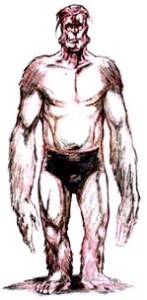 What changed? Well, in those two drafts above, Cyclops and Storm get scenes from their childhood right after Magneto’s. The Beast is a main character in the first draft, a supporting character in the second and is completely gone by the final film. The Blob was a member of the Brotherhood in the first two drafts and didn’t make the cut. Pyro was a main bad guy in these two drafts, fighting Jean and Cyclops at the Statue of Liberty. He did make the cut into the film, albeit in a cameo as a student at Xavier’s school. There is a scene in the train station and a scene in a shopping mall in these two drafts that were combined into one scene in the film. There is (surprise!) a Danger Room scene in the first draft. Also in the first draft, Senator Kelly arrives at the X-mansion via the toilet and not through the front door. And there is a full-on attack of the school by Magneto and Mystique in these early drafts, instead of it just being Mystique sneaking in to sabotage the Cerebro.
What changed? Well, in those two drafts above, Cyclops and Storm get scenes from their childhood right after Magneto’s. The Beast is a main character in the first draft, a supporting character in the second and is completely gone by the final film. The Blob was a member of the Brotherhood in the first two drafts and didn’t make the cut. Pyro was a main bad guy in these two drafts, fighting Jean and Cyclops at the Statue of Liberty. He did make the cut into the film, albeit in a cameo as a student at Xavier’s school. There is a scene in the train station and a scene in a shopping mall in these two drafts that were combined into one scene in the film. There is (surprise!) a Danger Room scene in the first draft. Also in the first draft, Senator Kelly arrives at the X-mansion via the toilet and not through the front door. And there is a full-on attack of the school by Magneto and Mystique in these early drafts, instead of it just being Mystique sneaking in to sabotage the Cerebro.
All these changes were put into effect to help X-Men reach a $75 million dollar budget, a figure that was shockingly low for a film of this type. To put the budget in perspective, the Mel Gibson comedy, What Women Want, had a budget only $5 million dollars less than the X-Men. The chintzy budget was one of the main reasons why there was so much negative buzz about the picture before its release. Another reason was the casting of the role of Wolverine.
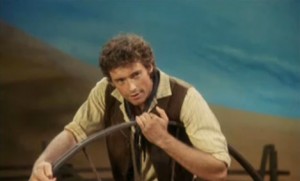 Hindsight is 20/20, but, looking back, it is impossible to consider anyone else but Hugh Jackman playing the clawed Canadian. He completely owns the role. But he wasn’t the first choice. He wasn’t the second choice either. Heck, he was, at best, the eighth or ninth choice for the part.
Hindsight is 20/20, but, looking back, it is impossible to consider anyone else but Hugh Jackman playing the clawed Canadian. He completely owns the role. But he wasn’t the first choice. He wasn’t the second choice either. Heck, he was, at best, the eighth or ninth choice for the part.
Bryan Singer’s first choice was Russell Crowe, an intriguing choice but with a tight budget, the film couldn’t afford him and he wasn’t willing to settle for less. The studio wanted either Keanu Reeves (???) or Gary Sinese for the role. Aaron Eckhart, Edward Norton and Viggo Mortensen were also in the running. Dougray Scott was actually cast in the role, but had to drop out when Mission Impossible II (in which he had a role) went over schedule. Jackman was a stage actor from Australia who specialized in musicals (his most notable role outside of his home continent was in Trevor Nunn’s production of Oklahoma that played in London’s West End in 1998). A song and dance man? As the toughest X-Man? Man, if we could go back in time and set our earlier selves straight.
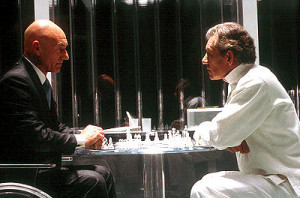 While Jackman’s casting was one of concern, the casting of Professor X and Magneto wasn’t. Patrick Stewart was an obvious choice for Xavier—fans were calling for his casting ever since Star Trek:The Next Generation was on the air. And for Magneto, we got one of the finest actors of our generation, Ian McKellen. The result was two classically trained, Shakepearean actors bringing out all the nuances of the Martin Luther King vs Malcolm X qualities of their character’s relationship. If we had to start from scratch today and recast the film, the only three I would keep would be Jackman, Stewart and McKellen.
While Jackman’s casting was one of concern, the casting of Professor X and Magneto wasn’t. Patrick Stewart was an obvious choice for Xavier—fans were calling for his casting ever since Star Trek:The Next Generation was on the air. And for Magneto, we got one of the finest actors of our generation, Ian McKellen. The result was two classically trained, Shakepearean actors bringing out all the nuances of the Martin Luther King vs Malcolm X qualities of their character’s relationship. If we had to start from scratch today and recast the film, the only three I would keep would be Jackman, Stewart and McKellen.
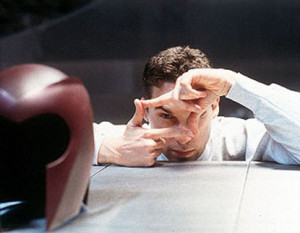 Bryan Singer originally didn’t want to direct the film, thinking a comic book film would be beneath him. However, when the comics were forced on him, he was drawn to the allegories contained in the comic, the fact that the persecuted X-Men could be seen as a commentary into everything from Civil Rights to the Communist Witch Hunts of the 1950s to the Gay Rights Movement. He blended this subtext seamlessly into the action film, and the final product was much stronger for it.
Bryan Singer originally didn’t want to direct the film, thinking a comic book film would be beneath him. However, when the comics were forced on him, he was drawn to the allegories contained in the comic, the fact that the persecuted X-Men could be seen as a commentary into everything from Civil Rights to the Communist Witch Hunts of the 1950s to the Gay Rights Movement. He blended this subtext seamlessly into the action film, and the final product was much stronger for it.
The film was the ninth-highest grossing film in 2000, more than tripling its lower-than-average budget worldwide. That, of course, means sequels. Next time, we’ll start charting the highs—and dreadfully low lows—that were the X-Men spin-offs and sequels.




